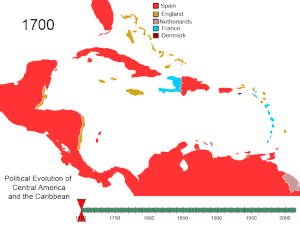
Back تاريخ أمريكا الوسطى Arabic Historia de Centroamérica AST Үҙәк Америка тарихы BA Història de l'Amèrica Central Catalan Dějiny Střední Ameriky Czech Geschichte Mittelamerikas German Historia de América Central Spanish Erdialdeko Amerikako historia EU تاریخ آمریکای مرکزی FA Histoire de l'Amérique centrale French
This article needs additional citations for verification. (December 2021) |

Central America is commonly said to include Guatemala, Belize, El Salvador, Honduras, Nicaragua, Costa Rica, and Panama. This definition matches modern political borders. Central America begins geographically in Mexico, at the Isthmus of Tehuantepec, Mexico's narrowest point, and the former country of Yucatán (1841–1848) was part of Central America. At the other end, before its independence in 1903 Panama was part of South America, as it was a Department of Colombia. At times Belize, a British colony until 1981, where English instead of Spanish is spoken, and where the population is primarily of African origin, has been considered not part of (Spanish-speaking) Central America.

Long and narrow, Central America does not have an obvious geographical center. Until the middle of the 20th century there were no roads between the countries, which isolated them from each other, and railroads have never connected them. During colonial times Guatemala was the administrative and religious center; religiously it remains so. However, attempts to create a Central American Political Union, like the European Union, have failed. The countries that joined the EU already had extensive cross-border traffic by train; even today (2021) there is by comparison very little, and none by train.
The countries, furthermore, are more diverse than they appear at first glance. Some (Guatemala) have a large indigenous or Native American population, others (Costa Rica) do not. Some (El Salvador) are focused on their Pacific coast, while in others (Belize, Honduras) the Caribbean or Atlantic coast is more important. Panama and to a lesser extent Guatemala and Costa Rica have both coasts playing a significant role. Some countries have stable governments (Costa Rica), others do not (Nicaragua, El Salvador). Panama is heavily Americanized, uses the US dollar as its currency, has a large industry and source of revenue (the canal), and a sophistication which comes from the ships and people passing through the country and previously the U.S. military installations in the former Canal Zone.
